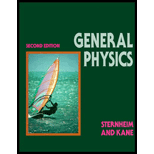
Concept explainers
(a)
To show that the electric field normal to the wire of length extending from
(a)
Answer to Problem 22E
The electric field normal to the wire of length extending from
Explanation of Solution
Observe the Figure 16.18.
Write the expression for the linear charge density of the wire.
Here,
For an elemental length
From Figure 16.18a, the distance to an arbitrary point
This gives the magnitude of electric field due to the charge
Use equation (II) in (III).
The total field can be resolved into horizontal and vertical components given by,
Among them the horizontal components the electric field due to two elementary lengths of the wire equidistant from the center cancel each other. Thus,
From Figure 16.18b,
The vertical component of the elementary field is thus obtained as,
Thus the net electric field is obtained by integrating over the length of the wire. In this case the wire extends from
Use the standard integration formula Equation B.46 in Appendix B of the text book.
Use equation (VII) for determining the integral in equation (VI).
This shows that the electric field normal to the wire of length extending from
Conclusion:
Therefore, the electric field normal to the wire of length extending from
(b)
To show that the equation
(b)
Answer to Problem 22E
The equation
Explanation of Solution
For infinitely long wire the integration limits in equation (VI) becomes
Conclusion:
Therefore, the equation
Want to see more full solutions like this?
Chapter 16 Solutions
General Physics, 2nd Edition
- If a charged particle moves in a straight line, can you conclude that there is no magnetic field present?arrow_forwardWhat magnetic field is required in order to confine a proton moving with a speed of 4.0 × 106 m/s to a circular orbit of radius 10 cm?arrow_forwardI have a question, to find force exerted by electromagnet. Is it FH = (μr * μ₀ * (N * I)^2 * A) / (2 * x^2) or FH = (μr * μ₀ * N^2 * I^2 * A) / (2 * x^2). Please show the correct one by deriving from Ampere and Biot-Savart Law.arrow_forward
- An electron in a TV CRT moves with a speed of 6.00×107 m/s , in a direction perpendicular to the Earth’s field, which has a strength of 5.00×10−5 T . (a) What strength electric field must be applied perpendicular to theEarth’s field to make the electron moves in a straight line? (b) If this is done between plates separated by 1.00 cm, what is the voltage applied? (Note that TVs are usually surrounded by a ferromagnetic material to shield against external magnetic fields and avoid the need for such a correction.)arrow_forwardTwo parallel wires, separated by a perpendicular distance of 5.0 cm, carry currents of 5.0 A and 2.0 A in the same direction. What force does the 5.0-A wire exert on a 50 cm-length of the 2.0-A wire? a. 60 μN, repulsive b. 40 μN, attractive c. 20 μN, attractive d. 80 μN, attractive e. 100 μN, attractivearrow_forwardTwo straight, parallel, superconducting wires, 4.5 mm apart from each other, carry equal currents of 15, 000 A in the same directions. They are both 3 meters long. What force per unit length does each wire exert on the other? Is the force attractive or repulsive?arrow_forward
- A particle of mass 1.00 x 10-9 kg and charge 3.00 pC is moving in a vacuum chamber where the electric field has magnitude 2.00 x 103 N/C and is directed straight upward. Neglecting other forces except gravity, calculate the particle’s (a) acceleration and (b) velocity after 2.00 s if it has an initial velocity of 5.00 m/s in the downward direction.arrow_forwardTwo atoms of the same substance, one singly ionized and the other triply ionized, are eachaccelerated from rest through same potential difference. The ions enter the same uniformmagnetic field at 90 degrees. Derive an expression fora) their velocity (V2/ V1) entering the field. b) their radii (r2/ r1) of curvature in the field.arrow_forwardTwo atoms of the same substance, one singly ionized and the other triply ionized, are eachaccelerated from rest through same potential difference. The ions enter the same uniformmagnetic field at 90o. Derive an expression fora) their velocity (V2/ V1) entering the field.b) their radii (r2/ r1) of curvature in the field.arrow_forward
 Principles of Physics: A Calculus-Based TextPhysicsISBN:9781133104261Author:Raymond A. Serway, John W. JewettPublisher:Cengage Learning
Principles of Physics: A Calculus-Based TextPhysicsISBN:9781133104261Author:Raymond A. Serway, John W. JewettPublisher:Cengage Learning

